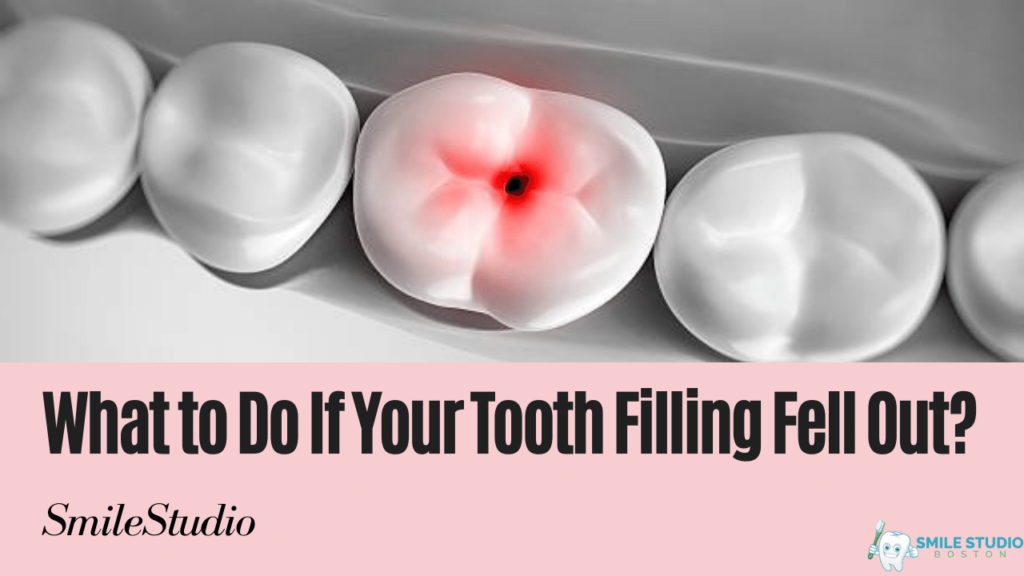It’s not uncommon to see a tooth filling fell out. In fact, dental fillings don’t last forever and sometimes, they can come loose or fall out. This can happen due to various reasons such as new decay around the filling, chewing too hard, biting into hard or crunchy foods, grinding your teeth (bruxism), trauma to the tooth or root, or a chemical reaction that loosens the bond of the filling to the tooth.
What to Do If Your Tooth Filling Fell Out? it’s important to take immediate steps to protect the tooth involved. The first step is to call your dentist to set up an appointment. In the meantime, until you see your dentist, there are several measures you can take to protect your exposed tooth:
1. Gargle with salt water to keep the area clean and remove any food debris from the tooth.
2. Brush the area very gently where the filling came out.
3. Avoid chewing on the area of the exposed tooth.
4. Use dental wax or temporary filling material, available online, to protect the exposed tooth.
Remember, these are only temporary solutions until you can get the filling repaired at your dentist. It’s crucial to get your filling replaced as soon as possible to prevent further complications.
Also Read: Are Root Canals Painful? Busting Myths and Revealing Facts
Immediate Actions
When your tooth filling fell out, it’s natural to feel a bit of panic. However, it’s important to stay calm and take immediate actions to protect your tooth and oral health.
Firstly, avoid swallowing or biting the filling as it could damage other teeth. If possible, try to keep the filling that has been released, especially if it is a gold or porcelain filling. The next step is to call your dentist and make an appointment. They will be able to provide the best advice and treatment plan for your situation.
In the meantime, there are a few things you can do to care for your tooth. One of the most effective immediate actions is to rinse your mouth with salt water. Mix 1/2 teaspoon of salt in a cup of warm water and gargle for a few seconds. This can help kill bacteria that could damage your exposed tooth and also remove any food debris from the tooth. It also helps prevent infection and soothes the area temporarily.
Remember, these are only temporary solutions until you can get the filling repaired at your dentist. It’s crucial to get your tooth filling replaced as soon as possible to prevent further complications.
Also Read: What is Root Canal Therapy: Your Questions Answered
What to Do If Your Tooth Filling Fell Out?
When a tooth filling fell out, it can be quite a surprise, but it’s a fairly common occurrence and there are several reasons why this might happen:
1. New Decay Around the Filling: If the tooth continues to decay in the same area or in a different spot that reaches the filling site, the filling will not have anything hard to hold onto and will fall out. This is one of the main reasons fillings pop out of teeth.
2. Chewing Too Hard or Biting into Hard Foods: Excessive force from chewing hard or crunchy foods can cause a filling to loosen or fall out.
3. Grinding Your Teeth (Bruxism): If you grind your teeth, the repeated pressure can be too much for the filling to handle, causing it to pop out.
4. Trauma to the Tooth or Root: Any trauma to the tooth or root can cause a filling to come loose or fall out.
5. Chemical Reaction: Occasionally, a chemical reaction can occur in the filling that causes it not to bond with your tooth, thus falling out in the days or weeks after being placed in your tooth.
Understanding why tooth filling fell out is important, but it’s equally important to remember that regular dental checkups are crucial to monitor the condition of your fillings. Regular checkups allow your dentist to detect any loose or damaged fillings early on, which can prevent them from falling out and causing further complications. If your tooth filling fell out, it’s crucial to get it replaced as soon as possible to prevent further complications.
Also Read: Root Canal Therapy Explained: How It Saves Teeth and Prevents Further Damage
Temporary Measures
If your tooth filling fell out and you can’t see your dentist immediately, there are a few temporary measures you can take to protect your tooth:
1. Rinse the Area: Rinse the area with warm water to clean it and remove any debris. This can help prevent infection and soothe the area temporarily.
2. Use Temporary Filling Material: You can use dental wax or over-the-counter temporary filling material to cover the gap and protect the tooth. This is a stopgap measure until your dentist can restore the filling.
3. Avoid Certain Foods: Try to avoid eating hard or sticky foods that could cause further damage to the tooth.
4. Gentle Brushing: Brush the area very gently where the filling came out. This can help keep the area clean and prevent further damage.
Remember, these are only temporary solutions. It’s crucial to get your tooth filling replaced as soon as possible to prevent further complications.
Seeking Professional Help
When your tooth filling fell out, it’s crucial to contact a dentist as soon as possible. A professional will need to assess the situation to prevent further damage or decay. Even if you’re not in pain, you should still make an appointment with your dentist. They can provide advice on caring for your tooth in the meantime and schedule an appointment for a replacement.
During your dental visit, your dentist will examine the tooth and may take an X-ray to assess the damage. They will determine whether the filling can simply be replaced or if other treatments are necessary. For example, if there is new decay around the filling, additional treatment may be needed.
Remember, if a tooth filling fell out, it is not usually considered an emergency, but it does require prompt attention. Leaving the tooth exposed for too long can lead to pain, infection, and further decay. So, take your time seeking professional help.
Prevention Tips
Preventing a tooth filling from falling out is largely about maintaining good oral hygiene and protecting your teeth from damage. Here are some tips to help you care for your fillings and prevent future issues:
1. Maintain Good Oral Hygiene: Brush your teeth twice a day and floss regularly. Use a fluoride toothpaste to strengthen your teeth and prevent decay.
2. Limit Sugary Snacks: Try to stick to healthy foods and limit your intake of sugary snacks. Sugar can lead to tooth decay, which can cause your fillings to come loose.
3. Avoid Hard Foods: Chewing hard foods can cause a filling to crack or come loose. Try to avoid biting down on hard objects like ice or hard candy.
4. Protect Against Grinding: If you grind your teeth while you sleep or clench your jaw during exercise, consider wearing a mouthguard. This can help protect your fillings from the pressure caused by grinding.
5. Regular Dental Check-ups: Schedule regular dental check-ups to detect any potential issues early on. Your dentist can monitor the condition of your fillings and take action if they notice any signs of wear and tear.
Remember, even with these prevention tips, fillings only last for a while and can fall out over time. If your tooth filling fell out, contacting your dentist as soon as possible is crucial to prevent further complications.
Transform Your Smile Today with SmileStudio!
Don’t wait until your tooth filling fell out to take action. Regular dental check-ups are crucial for maintaining your oral health and ensuring the longevity of your fillings. At Smile Studio, we’re committed to providing you with the highest quality dental care. If you suspect any issues with your fillings or simply need a routine check-up, don’t hesitate to contact us. Remember, your smile is our priority. Schedule your appointment today, and let us help you maintain that healthy, beautiful smile.
FAQs
1. How long can you leave a filling that has fallen out?
If a filling falls out, it’s recommended to see a dentist as soon as possible. If the tooth is left unprotected for more than 3 days, the dentist may have to place a dental crown.
2. What happens if a dental filling falls out?
When a filling falls out, the sensitive inner layers of the tooth are exposed to air, pressure, cold, and heat, which can be uncomfortable. It’s important to protect the tooth and contact a dentist immediately to prevent further damage.
3. How do dentists fix a lost filling?
Dentists fix a lost filling by first examining the tooth and then deciding on the best course of action. This could involve replacing the filling or opting for a different treatment like a root canal procedure and a crown.
4. Can you put a filling back in?
It is possible to reattach a filling temporarily using a suitable, non-toxic product safe for the mouth. However, this is not a permanent solution and a dentist should still be consulted.
5. Is it a big deal if a filling falls out?
Yes, it is significant if a filling falls out. Even if there’s no pain, the filling needs to be replaced to prevent further dental complications. A missing filling can expose the tooth to decay and other issues.
6. Is it painful if a filling falls out?
If a filling falls out, it can cause pain because it exposes the sensitive inner layers of the tooth to hot, cold, and pressure. However, the level of discomfort can vary depending on the individual and the specific tooth involved.


